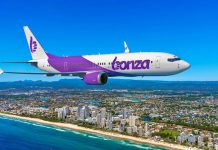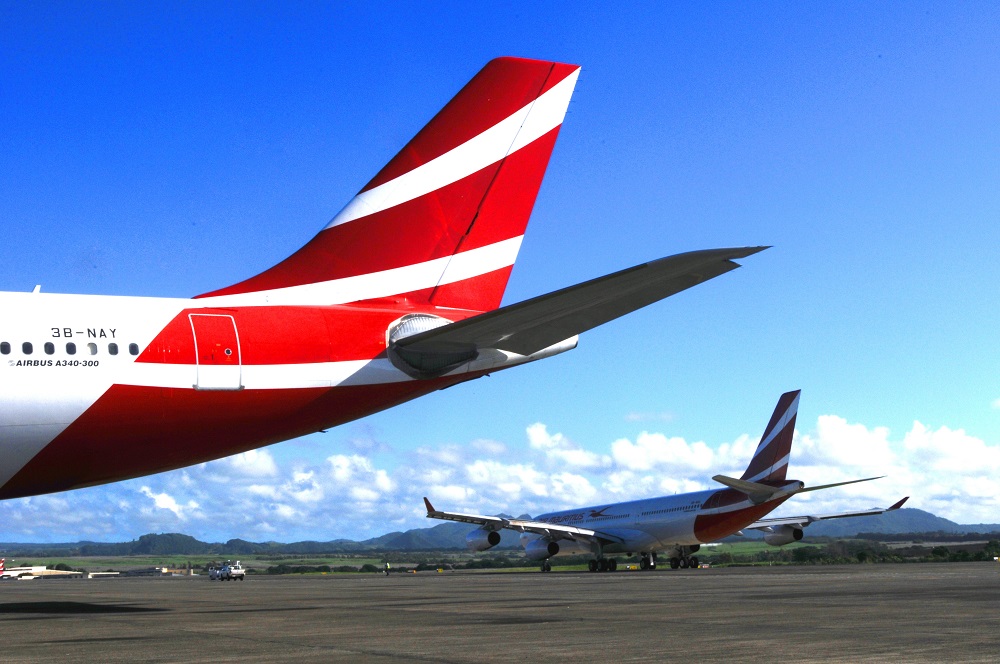Nobody beats Somas Appavou in praising the qualities of the Airbus A350, something that’s not surprising given his previous job was as an Airbus salesman based in Dubai.
In 2017 he returned to his home island and former employer to become CEO of Air Mauritius.
And, of course, he is immensely satisfied with the two A350s currently in his fleet.
“It has a very high dispatch reliability and the fuel burn is as low as promised, 15 percent less than the A340,” he says while talking to airlineratings in Mauritius.
When the first aircraft arrived in October, 2017, the event was televised live and the Prime Minister gave a speech. That’s how important this event was for the whole island nation.
The two A350-900s are flying currently on daily routes from Mauritius to Johannesburg, as well as to Paris-CDG.
READ: New Fortaleza gateway shaves hours off travel from Europe to Brazil.
Air Mauritius is getting four more A350s but has pushed out deliveries until 2023.
In the meantime, the island airline will receive two A330-900neos from Toulouse in autumn of 2018, being among the first operators worldwide.
“We bought the A330-900neos for routes that don’t need the range of the A350, the A330s will go to Asian cities as well as Perth and Geneva,” reveals Appavou.
Perth, served four times a week, already gets a healthy feed of connecting traffic from destinations such as Nairobi and South Africa.
“More and more Australians are discovering Mauritius rather than going elsewhere where safety is a topic Appavou says., “Also, we see more and more South Africans meeting family living in Australia for a holiday together, meeting half way – in Mauritius.”
When the new A330neos arrive, four A340-300s will be phased out. The airline currently operates six and two A340s it owns will get a new cabin upgraded to A350 standards by the end of 2018. These two enduring A340s will then be replaced by the last two remaining A350s by 2023.
“For long haul, we then have the number of aircraft to do the job, we will not order beyond six A350s,” the airline executive notes. “Our focus is now to expand Mauritius as a regional hub.”

Mauritius in the southern Indian Ocean is booming as a tourist destination. The island, home to 1.26 million inhabitants, received 1.34 million visitors in 2017 and this year 1.41 million tourists are expected.
But the high seasonality of the tourism trade is s problem for Air Mauritius, as most sun-seekers arrive during the European winter.
“We need stability in our schedule and to be less dependent on seasonal travel, as is very common in tourism with many of the charter companies doing cherry-picking,” says Appavou.
And competition gets particularly heated in winter when carriers such as Alitalia, Austrian, Edelweiss, KLM and Lufthansa appear during peak season.
The two biggest players, behind the national carrier, are Emirates (operating two A380s in the 615-seat version daily) plus Turkish Airlines, with daily flights.
Emirates has a code sharing agreement with Air Mauritius and the airline gets cheap allocated seats that it can sell itself, a lucrative deal.
Turkish Airlines to the contrary is seen as a problem by Appavou.
“We are pressured by external powers to do Open Skies, but his is not the way it can be done,” he complains. “Turkey doesn’t even have a bilateral agreement with Mauritius. Turkish Airlines flies here under an interim agreement they pushed through. Eighty percent of their passengers are from Europe, not only taking traffic from us but also from other European carriers.”
That situation is especially threatening for the island carrier with a naturally limited home market dominated by tourism. While there are upwards of a million passengers arriving in Mauritius from abroad every year, only about 250,000 Mauritians begin their journey from here.
“We don’t have the economies of scale to compete with Emirates or Turkish, and we can even less compete on price,” the CEO adds.

After many years the idea is ripe to turn Mauritius into a global gateway to tap into traffic streams beyond the pure tourist market.
“Our only chance to remain on the market is to position ourselves as a bridge or hub between Africa and Asia, we have to tap into another segment, connecting traffic.”
Currently, only 7-10 percent of the carrier’s passengers are using Mauritius just to change planes. Turning the idea of a global gateway into reality seems a bit far-fetched, according to the analysts at the Centre for Aviation (CAPA).
“A much bigger Air Mauritius is required if the country is to succeed at becoming a bridge between Africa and Asia, it will need a significantly larger fleet,” states CAPA.
Currently, the island airline is the fourth largest Sub-Saharan African carrier and Bigger than market leader Ethiopian by the number of Asian destinations.
Air Mauritius serves four Chinese cities plus Hong Kong, besides Kuala Lumpur and its new strategic Asia hub in Singapore, where it cooperates directly with Changi airport to create connectivity.
But one problem is the low frequencies: there are only 20 weekly flights to twelve Asia/Pacific destinations (including India and Perth), while Ethiopian serves its seven Asian destinations daily.
The other obstacle on the way to becoming a bridge between Africa and Asia is the currently tiny route network on the African continent.
Air Mauritius serves three cities in South Africa, but only Johannesburg with daily flights, as well as Nairobi, Maputo and Dar es Salaam. There are too few destinations and frequencies to create meaningful transfer connections. And the airline also lacks suitable aircraft.
“We see our catchment area in a radius of about six flight hours around Mauritius, and to build up such a network we need single aisle aircraft,” says Appavou.
“Today we serve routes of up to seven hours like to Mumbai or Cape Town with the A319, but in the same radius are Singapore, Kuala Lumpur, Bangalore, Chennai or some other points in Africa like Luanda, these are all possible points for our expansion.”
In any case, there is enough traffic within this zone that the airline can tap into.
While Air Mauritius currently only operates two elderly A319s besides its Airbus wide-body fleet, it has started proceedings to order more smaller aircraft.
“We are at the beginning of the evaluation process to order four to six new single aisle aircraft, a firm decision can be expected by fall of 2019 at the latest. We are looking at the A320neo, 737 MAX, Embraer E2 and the CSeries”, reveals Appavou.
And he knows his immediate task: “We have to increase our passenger volumes in order to maintain our stability, while yields are always decreasing and costs going up by 3-4 percentevery year.”
This seems to work at least for 2018 as the airline expects to carry 1.7m passengers versus 1.5m the previous year.
























